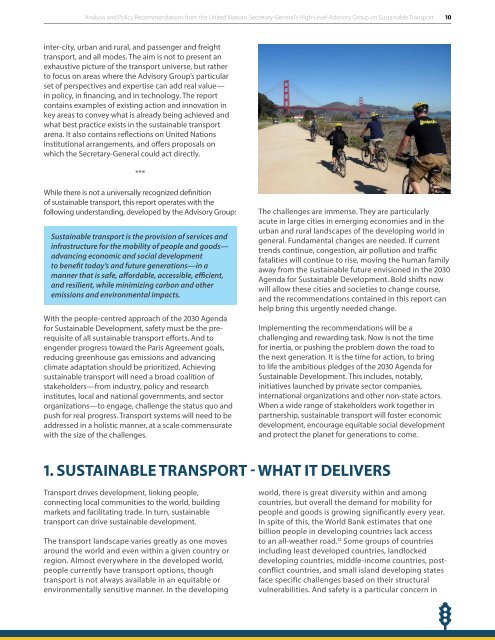MOBILIZING DEVELOPMENT
a5OQ306q56U
a5OQ306q56U
Create successful ePaper yourself
Turn your PDF publications into a flip-book with our unique Google optimized e-Paper software.
Analysis and Policy Recommendations from the United Nations Secretary-General’s High-Level Advisory Group on Sustainable Transport 10<br />
inter-city, urban and rural, and passenger and freight<br />
transport, and all modes. The aim is not to present an<br />
exhaustive picture of the transport universe, but rather<br />
to focus on areas where the Advisory Group’s particular<br />
set of perspectives and expertise can add real value—<br />
in policy, in financing, and in technology. The report<br />
contains examples of existing action and innovation in<br />
key areas to convey what is already being achieved and<br />
what best practice exists in the sustainable transport<br />
arena. It also contains reflections on United Nations<br />
institutional arrangements, and offers proposals on<br />
which the Secretary-General could act directly.<br />
***<br />
While there is not a universally recognized definition<br />
of sustainable transport, this report operates with the<br />
following understanding, developed by the Advisory Group:<br />
Sustainable transport is the provision of services and<br />
infrastructure for the mobility of people and goods—<br />
advancing economic and social development<br />
to benefit today’s and future generations—in a<br />
manner that is safe, affordable, accessible, efficient,<br />
and resilient, while minimizing carbon and other<br />
emissions and environmental impacts.<br />
With the people-centred approach of the 2030 Agenda<br />
for Sustainable Development, safety must be the prerequisite<br />
of all sustainable transport efforts. And to<br />
engender progress toward the Paris Agreement goals,<br />
reducing greenhouse gas emissions and advancing<br />
climate adaptation should be prioritized. Achieving<br />
sustainable transport will need a broad coalition of<br />
stakeholders—from industry, policy and research<br />
institutes, local and national governments, and sector<br />
organizations—to engage, challenge the status quo and<br />
push for real progress. Transport systems will need to be<br />
addressed in a holistic manner, at a scale commensurate<br />
with the size of the challenges.<br />
The challenges are immense. They are particularly<br />
acute in large cities in emerging economies and in the<br />
urban and rural landscapes of the developing world in<br />
general. Fundamental changes are needed. If current<br />
trends continue, congestion, air pollution and traffic<br />
fatalities will continue to rise, moving the human family<br />
away from the sustainable future envisioned in the 2030<br />
Agenda for Sustainable Development. Bold shifts now<br />
will allow these cities and societies to change course,<br />
and the recommendations contained in this report can<br />
help bring this urgently needed change.<br />
Implementing the recommendations will be a<br />
challenging and rewarding task. Now is not the time<br />
for inertia, or pushing the problem down the road to<br />
the next generation. It is the time for action, to bring<br />
to life the ambitious pledges of the 2030 Agenda for<br />
Sustainable Development. This includes, notably,<br />
initiatives launched by private sector companies,<br />
international organizations and other non-state actors.<br />
When a wide range of stakeholders work together in<br />
partnership, sustainable transport will foster economic<br />
development, encourage equitable social development<br />
and protect the planet for generations to come.<br />
1. SUSTAINABLE TRANSPORT - WHAT IT DELIVERS<br />
Transport drives development, linking people,<br />
connecting local communities to the world, building<br />
markets and facilitating trade. In turn, sustainable<br />
transport can drive sustainable development.<br />
The transport landscape varies greatly as one moves<br />
around the world and even within a given country or<br />
region. Almost everywhere in the developed world,<br />
people currently have transport options, though<br />
transport is not always available in an equitable or<br />
environmentally sensitive manner. In the developing<br />
world, there is great diversity within and among<br />
countries, but overall the demand for mobility for<br />
people and goods is growing significantly every year.<br />
In spite of this, the World Bank estimates that one<br />
billion people in developing countries lack access<br />
to an all-weather road. 12 Some groups of countries<br />
including least developed countries, landlocked<br />
developing countries, middle-income countries, postconflict<br />
countries, and small island developing states<br />
face specific challenges based on their structural<br />
vulnerabilities. And safety is a particular concern in


